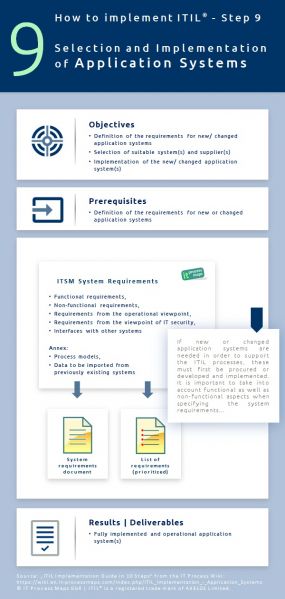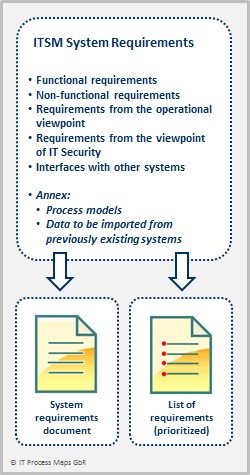ITIL Implementation - Application Systems


| Step 9: Setting up the Technical Infrastructure (Example: Selection and Implementation of Application Systems) |
Now that the process design is complete, the processes are ready for implementation.
If new or changed technical infrastructure is needed to support the ITIL processes, it must be acquired and deployed. The individual steps to be taken will depend on the type of infrastructure.
The following example outlines the necessary steps to define system requirements, select and implement application systems.
Objectives
- Definition of the requirements for new / changed application systems
- Selection of suitable system(s) and supplier(s)
- Implementation of the new / changed application system(s)
Define the Requirements
Objective of this Project Step
- Definition of the requirements for new or changed application systems
Description
The functional requirements for supporting infrastructure such as application systems can often be derived from the process design - these specify the activities to be supported by the applications.
The definitions of the process inputs and outputs describe which data are to be processed by the system. The Incident Management process, for example, generates Incident Records any system supporting that process must there¬fore be able to handle such data.
Finally, all non-functional requirements are to be recorded.
On the whole the following structure results for the system requirements document (see fig. 1: ITSM System Requirements):

- Functional requirements
- Reference to the detailed process models
- Additional requirements related to functionality
- Definitions of the process outputs (data-structures)
- Reporting functionality
- Non-functional requirements
- Requirements related to capacities and quantities
- Performance and turnover
- Scalability/ Expansion
- Availability
- Requirements from the operational viewpoint
- Requirements from the viewpoint of IT Security
- Interfaces with other systems
- Annex
- Process models
- Data to be imported from previously existing systems
Once the requirements are complete, an itemized and prioritized list is extracted from the requirements document, which is used as a matrix for the evaluation of suppliers. The requirements should be categorized, like in the following example:
- Knock-out criteria (Prio 1)
- Important requirements (Prio 2)
- Desirable requirements (Prio 3)
Prerequisites
- Detailed process descriptions in the form ITIL process flows
- Guidelines/ checklists
- Definitions of the process outputs
Results/ Deliverables
- System requirements document for applications to be changed or procured
- Prioritized list of requirements
Success factors
It is important not to limit oneself to functional aspects when pinning down the system requirements. Operational aspects are equally important, as are possibilities to expand the system – especially if the introduction of further ITSM processes is to follow.
Relevant Views of the ITIL Process Map
The detailed process descriptions from the ITIL Process Map are an important part of the system requirements.
In addition to this, checklists/ document templates support the definition of the process outputs. The attributes usually assigned to an Incident Record, for example, can be found in the Incident Record checklist.
Select System(s)
Objective of this Project Step
- Selection of suitable system(s) and supplier(s) for the application system due to be procured
Description
Suppliers of suitable ITSM systems are submitted to a systematic evaluation upon the basis of the list of requirements.
A three-stage approach has proved to be most efficient for this purpose:
- Firstly, a larger number of suppliers may be approached in writing; the aim here is to find suppliers which are able to fulfill the most important requirements.
- This results in a short-list of suppliers, who are requested to submit a concrete offer that also contains information about license fees and implementation costs.
- The final decision is made after a visit by reference clients and possibly a test-installation by the leading contender.
Prerequisites
- Requirements document for applications to be changed or procured
- Prioritized list of requirements
Results/ Deliverables
- Evaluation of systems and suppliers
Success factors
Once the requirements are documented, it will often be necessary to research the market and select suitable vendors of systems or other technical infrastructure.
The product surveys published by the Gartner [1] and Forrester [2] Groups often provide a good starting point for this task (please refer to www.gartner.com or www.forrester.com).
Implement the Systems
Objective of this Project Step
- Implementation of the new/ changed application system(s), so that they are ready to support the IT Service Management processes to be introduced
Description
Which individual steps must be taken for system implementation will depend in a great measure upon the type of application and its operational environment.
It is usually most efficient to make use of the system-suppliers' expertise when customizing and implementing the new application(s).
Prerequisites
- Selected system supplier(s)
- Detailed process descriptions in the form of ITIL process flows
- Guidelines/ checklists
- Definitions of the process outputs
Results/ Deliverables
- Fully implemented and operational application system(s)
Relevant Views of the ITIL Process Map
The detailed process descriptions and definitions of guidelines and process outputs serve as blueprints for the configuration of the systems.
Resources
- [1] Gartner, Inc., Analysts: Chris Matchett, Siddharth Shetty and Rich Doheny: Magic Quadrant for IT Service Support Management Tools. -- August 29, 2019
- [2] ZDNet.com - by Forrester Research: SaaS ITSM tools: Forrester delivers market overview. -- February 26, 2013.
Following project activity
→ ITIL Implementation - Step 10: Process Implementation and Training
Notes
By: Andrea Kempter ![]() , IT Process Maps.
, IT Process Maps.
Objectives › Define the Requirements › Select System(s) › Implement the Systems






